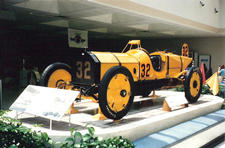1911 Indianapolis 500
 Ray Harroun earned a place in racing history on May 30, 1911, when he won the first Indianapolis 500. The running of the ninety-fifth “greatest spectacle in racing,” [there were no races during World War I and World II] on May 29 will commemorate the 100th anniversary of Harroun’s victory. For a complete history of the legendary race, see the new book, Through Blood and Smoke: A True Story of Mystery, Mayhem and the Birth of the Indy 500
Ray Harroun earned a place in racing history on May 30, 1911, when he won the first Indianapolis 500. The running of the ninety-fifth “greatest spectacle in racing,” [there were no races during World War I and World II] on May 29 will commemorate the 100th anniversary of Harroun’s victory. For a complete history of the legendary race, see the new book, Through Blood and Smoke: A True Story of Mystery, Mayhem and the Birth of the Indy 500
“Through Death Pall Roy [Ray] Harroun Dashes To Victory in Race”
Motor Speedway, Indianapolis, Ind., May 30
"One life was sacrificed and several men were injured in the first 500 mile race run on the speedway here, which was won by Roy Harroun, driving a Marmon car, in six hours, forty-one minutes, eight seconds. Closely pressing Harroun for victory were Ralph Mulfor, with a Lozier, and David Guee Brown, in a Fiat, a good third. With unflagging enthusiasm the crowds cheered the leaders in the last lot and watched the field as they wound around the course.
"The most serious accident of the day occurred when S.T. Dickson of Chicago, mechanic for Arthur Griener, driving an Amplix, lost his life in an upset on the last stretch. The race had been on but a few minutes and the car was in its thirtieth mile when the rim of one of the front wheels flew off. The car twisted on the track, hurling the driver and mechanic from their seats. Dickson was instantly killed, while Griener was unconscious when picked up. At the field hospital it was found that Griener’s only injury was a fractured arm.
"Succeeding accidents thrilled the immense crowds, which momentarily expected a carnival of deaths. The cars at times swept around the course in groups at terrific speeds. The men injured in the mishaps were Dave Louis, mechanic for Petty Petzla (Lozier), right leg broken near hip; Marri Knight, driver of Westcott, breast bruised; Johnnie Glover, Knight’s mechanic, body bruised; Bob Evans, mechanic for Jeff Tower (Jackson car), body bruised when he leaned from the car in a panic; Joe Wood, mechanic for Joe Jaecrsburger, (G.A. Case car), run over and badly bruised.
"The crowds were too large to be controlled by the militia, and scores of special police were posted about the grounds. The mob was wild with excitement after the first accident, and rushed back and forth over the fields when other accidents were reported.
"When Harroun took the lead in the one hundred and ninetieth mile the race took form and then the crowd’s interest was heightened and divided between the contest and the catastrophes that were momentarily impending. The cars began to cut their tires, burned out by the fierce grinding over the speedway’s brick pavement and steering gears began to give way. Directly in front of the grandstand Joe G. Case’s car got away from [him] and switched back and forth across the track. Wood, a mechanic, reached out and fell, and the car passed over him. He lay in a path of death, four cars were rushing upon him.
"More than 10,000 persons were lined up at the Speedway gates early today, five hours before the time scheduled for the start of the race. Never in the history of Indianapolis have such throngs visited the city. From almost every state in the Union automobile enthusiast flocked here. All night long automobiles poured through the streets. Hundreds, unable to find hotel accommodations, slept in their machines, which were park in the downtown streets. Many had slept in Riverview Park nearby, while others had propped themselves against the fence near the Speedway entrance. Early indications were that the crowd of 100,000 which was expected to witness the race might be far outstripped.
"Minor accidents in the downtown streets in collisions between automobiles and pedestrians...were common, while the talk of the crowd gathering before the race concerned 'how many might be killed' in the big event, in addition to speculation on the winner."
For the complete text of this article, see the Springfield (Mo.) Republican, May 31, 1911, page 1. To see newsreel footage of the first Indianapolis 500, click here.
Find this article at http://thelibrary.org/blogs/article.cfm?aid=1392